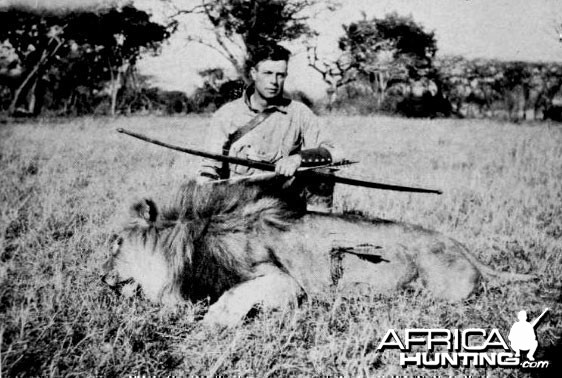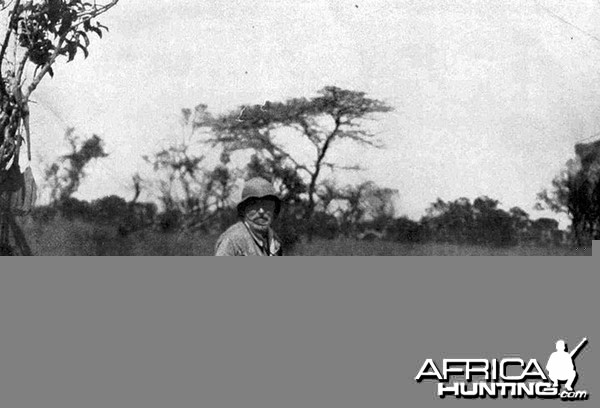- Joined
- Oct 1, 2007
- Messages
- 13,319
- Reaction score
- 9,595
- Website
- www.africahunting.com
- Media
- 5,597
- Articles
- 321
Vital Shots Lion
by Captain Chauncey Hugh Stigand (1877 - 1919)

This animal is by far the most dangerous in Africa, for in proportion to the number that have been shot there have been more fatal accidents with them than with any other animal.
The sportsman should, therefore, make a point of never firing at a lion until he is sure of his shot, for the first shot is the all-important one with all animals, and more especially with a lion, for it is very difficult to find when wounded, owing to its capability in taking cover, and because its colour harmonises so well with the surrounding country. If broadside on, shoot at the point of the shoulder, and if facing, at the base of the neck for a raking shot.
The head is a very uncertain mark unless the beast is close, and should not be tried. The same applies to the neck till one is fairly experienced.
Small-bore rifles, such as the "256 Mannlicher or "303, are quite efficient for lion, used with proper expanding bullets such as described in Chap. VIII.
It is a fact that lion are more easily killed than many of the small buck of this country, and die more quickly when hit well forward. If a lion charges it is best to keep a shot up one's sleeve until he is quite close, and there is little probability of missing him.
At the last moment a jump aside might save one, but it would be a toss up.
When following a wounded lion, a big-bore or shot-gun with S.S.G.'s should be taken.
If it goes into thick grass it should be burnt out, and if this is not possible one should wait till the next day.
Most of the fatal accidents which have occurred have been in following a wounded lion into grass, where the chances are greatly in favour of the animal.

The question of vital shots is a most important one, for, after the game is sighted, it is necessary that the sportsman should know exactly where to hit it, so as to kill it quickly, saving the animal perhaps many days of suffering, and the hunter the time and trouble of following it up.
Nothing is more distressing to the man with humane sporting instincts than to feel that he has sent an animal off with a painful wound to die slowly, tormented by flies, maggots, and the nightly terror it will suffer from lions, hyaenas, jackals, or hunting dogs.
It would be well, then, to shoot coolly, and not to aim at an animal's whole body, but at the exact spot you wish to hit.
Never jerk the rifle off, but press the trigger gently, and, when possible, sit down. When this is impossible, if a tree is handy, rest the rifle against it, taking care to have the arm or hand between the barrel and tree to prevent jump.
It would, perhaps, be better to take the animals in order of size and the difficulty in killing them.
by Captain Chauncey Hugh Stigand (1877 - 1919)
This animal is by far the most dangerous in Africa, for in proportion to the number that have been shot there have been more fatal accidents with them than with any other animal.
The sportsman should, therefore, make a point of never firing at a lion until he is sure of his shot, for the first shot is the all-important one with all animals, and more especially with a lion, for it is very difficult to find when wounded, owing to its capability in taking cover, and because its colour harmonises so well with the surrounding country. If broadside on, shoot at the point of the shoulder, and if facing, at the base of the neck for a raking shot.
The head is a very uncertain mark unless the beast is close, and should not be tried. The same applies to the neck till one is fairly experienced.
Small-bore rifles, such as the "256 Mannlicher or "303, are quite efficient for lion, used with proper expanding bullets such as described in Chap. VIII.
It is a fact that lion are more easily killed than many of the small buck of this country, and die more quickly when hit well forward. If a lion charges it is best to keep a shot up one's sleeve until he is quite close, and there is little probability of missing him.
At the last moment a jump aside might save one, but it would be a toss up.
When following a wounded lion, a big-bore or shot-gun with S.S.G.'s should be taken.
If it goes into thick grass it should be burnt out, and if this is not possible one should wait till the next day.
Most of the fatal accidents which have occurred have been in following a wounded lion into grass, where the chances are greatly in favour of the animal.
The question of vital shots is a most important one, for, after the game is sighted, it is necessary that the sportsman should know exactly where to hit it, so as to kill it quickly, saving the animal perhaps many days of suffering, and the hunter the time and trouble of following it up.
Nothing is more distressing to the man with humane sporting instincts than to feel that he has sent an animal off with a painful wound to die slowly, tormented by flies, maggots, and the nightly terror it will suffer from lions, hyaenas, jackals, or hunting dogs.
It would be well, then, to shoot coolly, and not to aim at an animal's whole body, but at the exact spot you wish to hit.
Never jerk the rifle off, but press the trigger gently, and, when possible, sit down. When this is impossible, if a tree is handy, rest the rifle against it, taking care to have the arm or hand between the barrel and tree to prevent jump.
It would, perhaps, be better to take the animals in order of size and the difficulty in killing them.
Last edited by a moderator: